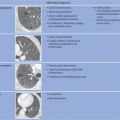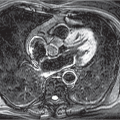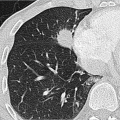Persistent or Migratory Pulmonary Infiltrates
Persistent or Migratory Pulmonary Infiltrates
Pulmonary infiltrates are very commonly detected in clinical practice. On chest radiography, they are usually interpreted as pneumonia, when this is consistent with the clinical symptoms, and treated with antibiotics. The initial working diagnosis must be critically reviewed if timely follow-up reveals:
Absence of adequate regression, or even progression, of the infiltrates.
New-onset infiltrates at hitherto unaffected locations (even in settings of infiltrate regression at the initial locations).
The myriad relevant differential diagnoses cannot be reliably excluded on imaging alone. Discussion of the further diagnostic and therapeutic procedures with clinicians is helpful in this situation. In addition to further clinical work-up, a chest
CT scan should definitely be obtained. A summary of relevant differential diagnoses is given in ▶
Table 23.1.
Bronchoscopy is generally needed as part of the further clinical work-up. The radiologic differential diagnoses impact the bronchoscopic procedure, e.g., conduct of transbronchial biopsy or of bronchoalveolar lavage.
Inflammatory markers identified in routine laboratory tests provide the first diagnostic insights.
23.1 Raised Inflammatory Markers
23.1.1 Infection
Calculated antibiotic therapy will not be able to achieve adequate resolution of pneumonia (▶
Fig. 23.1) if the chosen antibiotic is not effective against the causative pathogen. Bronchoscopy is aimed at identifying the causative pathogen; therefore, antibiotic treatment must be stopped prior to bronchoscopy to avoid suppression of bacterial growth in the obtained samples. Furthermore, pneumonia types against which conventional antibiotics are not effective must be considered:
Get Clinical Tree app for offline access









